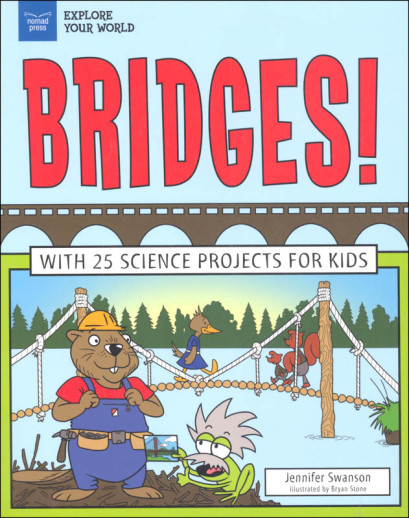We use cookies to make your experience better. To comply with the new e-Privacy directive, we need to ask for your consent to set the cookies. Learn more.
Bridges! (Explore Your World)
Bridges! With 25 Science Projects for Kids introduces readers ages 7 to 10 to the concepts and vocabulary of bridge construction through the lenses of history, science, engineering, math, and technology.
From the Golden Gate Bridge in San Francisco to the Tower Bridge in London, bridges are a huge part of our life. But how are these amazing structures built? What forces keep it standing? What might cause it to fall down? And who decides which type of bridge to use? In Bridges! With 25 Science Projects for Kids,one of four titles in the Explore Engineering set, readers discover how these extraordinary feats of engineering are created, and apply what they have learned to hands-on, critical-thinking activities that include building different types of bridges, such as truss, cantilever, and suspension bridges, out of different materials and modeling different types of supports. They examine the natural forces that affect structure selection and appearance, and also learn about the types of support required for each. Trivia, cartoon illustrations, links to online videos and other sources, and clear diagrams round out this book and make it fun and interesting for class discussions.
Following the guidelines set forth in the NGSS/NSTA engineering and design standards, teachers can feel comfortable using this book as a guide for targeted learning in their classrooms. In the Explore Engineering set, readers ages 7 to 10 develop foundational understanding of the physics that guides the building and maintenance of bridges, canals, dams, tunnels, and skyscrapers.
This series explores STEM concepts and applied sciences. Each book includes 25 projects, averaging a few each chapter. Projects can vary from the simple (like making ocean salt water or forming an arch with your body) to more complicated STEAM projects (wind force; building design; or learning binary code). Adult supervision recommended for these kid-friendly projects. Call-Out sections include explanatory text, vocabulary with definitions, "Did you Know?" sections (with cool "factoids"), Investigate questions, project directions—and even "dad jokes." Throughout each book, periodic QR codes help readers explore additional concepts on external websites. You'll be able to choose from a few activities or match an activity to your child's appropriate grade—or have your budding scientist engage in them all! Includes a theme-focused timeline, essential questions, metric conversions, glossary, resources, and index. See each product description for specific content. Printed in the U.S. Size is 8"x 10". 90 pgs, pb. ~ Ruth
| Product Format: | Paperback |
|---|---|
| Brand: | Nomad Press |
| Grades: | 2-5 |
| ISBN: | 9781619305915 |
| Length in Inches: | 10 |
| Width in Inches: | 8 |
| Height in Inches: | 0.25 |
| Weight in Pounds: | 0.55 |

